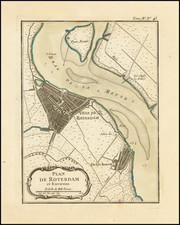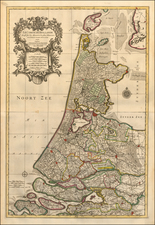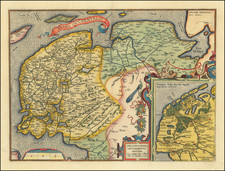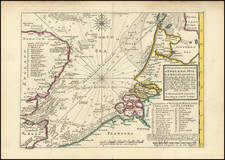Finely colored example this detailed map of Zeeland, dedicated to Johan de Knuyt.
Includes two decorative cartouches with coats of arms, sailing ships, etc.
Johan de Knuyt (March 6, 1587 - December 17, 1654) was a distinguished Zeeland regent and representative of the First Noble in Zeeland. Born in Middelburg to Laurens de Knuyt, appointed by William of Orange, and Marguerite Lenaerts, he was deeply rooted in political and noble circles. His marriage to Carolina Tenys, part-owner of Oud- and Nieuw Vossemeer, further solidified his status. De Knuyt, who left a notable legacy to the Middelburg diaconate, played a crucial advisory role to Prince Frederick Henry, impacting significant diplomatic negotiations with France and Spain to end the Eighty Years' War.
De Knuyt's political journey began in Middelburg's municipal council, leading to his mayorship in 1612. By 1616, he was a Zeeland delegate to the Generaliteitsrekenkamer in The Hague, continuing in this role even after becoming Frederick Henry's advisor. His remarkable feat in 1630, saving the principality of Orange from Jean de Hertoge van Osmael, earned him Frederick Henry's lifelong gratitude and a representative role in the Zeeland Estates.
Around 1630, sensing the Republic's growing strength, Frederick Henry dispatched De Knuyt and Adriaen Pauw to France. Their successful alliance forged with France included plans to divide the Southern Netherlands along linguistic lines. Despite failing to reconcile Maria de' Medici with her son, King Louis XIII of France, in 1638, De Knuyt's efforts led to the renewal of the Franco-Dutch alliance in 1644.
De Knuyt's moderate stance was evident during the negotiations preceding the Peace of Münster. Despite accusations of bribery from the French and disagreements with Pauw, he maintained his position. However, following Frederick Henry's death, De Knuyt's influence waned. He lost his representative role after William II's death and, by 1654, the Zeeland Estates restricted his participation, only accepting his explanations for his actions during the Münster negotiations.
Jan Janssonius (also known as Johann or Jan Jansson or Janszoon) (1588-1664) was a renowned geographer and publisher of the seventeenth century, when the Dutch dominated map publishing in Europe. Born in Arnhem, Jan was first exposed to the trade via his father, who was also a bookseller and publisher. In 1612, Jan married the daughter of Jodocus Hondius, who was also a prominent mapmaker and seller. Jonssonius’ first maps date from 1616.
In the 1630s, Janssonius worked with his brother-in-law, Henricus Hondius. Their most successful venture was to reissue the Mercator-Hondius atlas. Jodocus Hondius had acquired the plates to the Mercator atlas, first published in 1595, and added 36 additional maps. After Hondius died in 1612, Henricus took over publication; Janssonius joined the venture in 1633. Eventually, the atlas was renamed the Atlas Novus and then the Atlas Major, by which time it had expanded to eleven volumes. Janssonius is also well known for his volume of English county maps, published in 1646.
Janssonius died in Amsterdam in 1664. His son-in-law, Johannes van Waesbergen, took over his business. Eventually, many of Janssonius’ plates were sold to Gerard Valck and Pieter Schenk, who added their names and continued to reissue the maps.










![[Den Helder and Environs] Nieueve Diep](https://storage.googleapis.com/raremaps/img/small/74774.jpg)
![[Course of the Rhine River] Corso del Reno Parte Septentrio [and] Corso del Reno Parte Meridionale . . . 1690](https://storage.googleapis.com/raremaps/img/small/73095.jpg)


